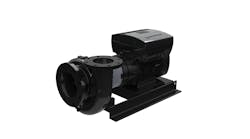Many industries suffer some of the same problems that our industry does when it comes to the jargon used by its tradesmen. Acronyms make it even more difficult in most cases, because when people don’t know or understand, they make things up. For example, PRV — is it a pressure-reducing valve or a pressure-relief valve? There’s a big difference between the two.
One area of concern for hydronics folk is the use of the term “pump” versus “circulator.” Visually, they are one and the same. Technically speaking, they both create a pressure differential for the purposes of moving a liquid. Maybe we should change their names to PDM (pressure differential machines). That way, regardless of the application, everyone associated with the industry would know exactly what it was that you were referring to if you said you needed a PDM.
In my many years of experience, I’ve learned that the difference between the two is the end application. If the PDM is used to physically “lift” water, therefore overcoming atmospheric pressures, then it is considered a “pump.” Think of a submersible well pump; it physically lifts water from way down below the earth’s surface, generating enough additional pressure to cause the water to move through pipes to the point of use. Once it reaches a fixture such as a showerhead or toilet, enough pumping pressure remains to cause the device to operate as designed. This is the function of a true pump.
In my many years of experience, I’ve learned that the difference between the two is the end application.
Our industry friend Dan Holohan explains an operating circulator as being the functional equivalent of a ferris wheel ride. Once the ride is full, the weight of the people being raised to the top of the ride is countered by the weight of the people revolving to the bottom of the ride. The motor that actually performs the work isn’t really working all that hard, except when the ride is being loaded up. This is when the motor will struggle the most. Once the ride is loaded with people, the pump’s workload is significantly reduced.
In a hydronic application, a “drainback” solar thermal system can use a “circulator” as a pump. However, its minimum net positive suction head pressure (NPSHA) must be maintained in order for it to perform to its rated performance curve. That’s a whole other subject for coverage at another time, but what I am trying to show is that it doesn’t matter what you call it, it matters how you use it.
Even in the case of the drainback solar system, once the fluid has been lifted all the way to the top of the system, there has to be enough residual pressure available to start water flowing downward in the downcomer (return) piping. In fact, the velocity of the fluid has to be such that it actually establishes a siphon in the downcomer. Now, instead of physically having to lift all the fluid vertically to the top of the system, the weight of the water flowing down the return pipe counters the weight of the water being lifted up the supply riser, and what was a pump seconds ago now becomes a circulator. Amperage draw will drop significantly, and the flow rate will increase significantly in seconds, once the siphon has been established.
This process will continue as long as the PDM remains in the “on” position. It is critical that the downcomer be terminated above the highest standing column of water in the reservoir tank, because when the PDM turns off, the weight of the water will cause the riser to flow backward, causing the upper portion of the system to drain back into the heat of the building. If the return pipe were terminated below the standing column of water in the reservoir, the water would be held in suspension, exposing the solar collectors to the real possibility of incurring freeze damage. Think straw full of water with a finger held over the top of it, holding the water in a vacuum. This required “air gap” can be as simple as a 1/8” hole drilled in the return pipe just inside the reservoir where the pipe enters, but it must be present or water will freeze in the pipe and damage the pipe or even the solar collectors. No check valve is used anywhere in a drainback system’s solar loop.
If the pump is marginally sized to only lift the water to the highest point of the system, and not left with enough residual energy to establish a siphon on the downcomer, it enters a “stall.” Water reaches the high point of the system, but the undersized pump doesn’t provide adequate pumping “head” to push it over the top of the hill and begin its journey down.
Now you know the difference between a circulator and a pump, and as I have just demonstrated, it can change mid-stream.
Now you know the difference between a circulator and a pump, and as I have just demonstrated, it can change mid-stream; so as with any hydronic question, there is only one correct answer. That answer is “It depends ...” But now you know.
If you’ve not yet joined the Radiant Professionals Alliance, check us out at Radiantpros.org. The RPA is a very worthwhile organization to belong to that is here to support the industry.
Mark Eatherton material on this website is protected by Copyright 2016. Any reuse of this material (print or electronic) must first have the expressed written permission of Mark Eatherton and CONTRACTOR Magazine. Please contact via email at: [email protected].
About the Author
Mark Eatherton
Mark Eatherton material on this website is protected by Copyright 2017. Any reuse of this material (print or electronic) must first have the expressed written permission of Mark Eatherton and CONTRACTOR Magazine.
